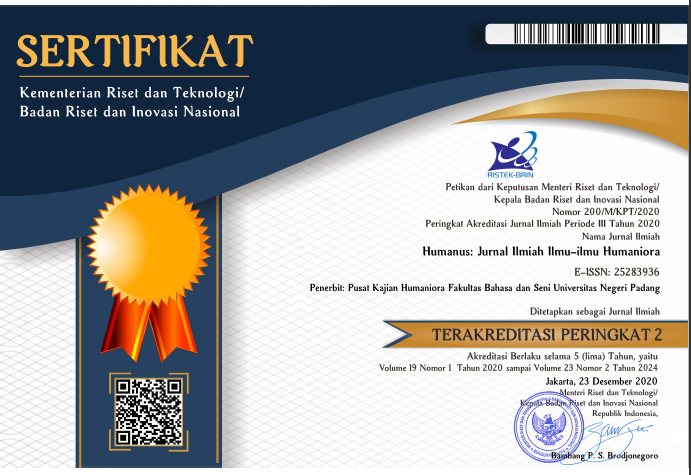Black Images in Contemporary Slavery-Themed Novel Written by Whites American: Reflecting the Persistence of White Supremacy
 ), La Bilu Bilu(2),
), La Bilu Bilu(2), (1) Universitas Halu Oleo
(2) Universitas Halu Oleo
 Corresponding Author
Corresponding Author
Copyright (c) 2021 Humanus
DOI : https://doi.org/10.24036/humanus.v20i2.112267
Full Text:
 Language : en
Language : en
Abstract
This study investigates images of black (and white) characters in contemporary American slavery-themed novel written by white authors, focusing on two novels, Property (2003) and Rhett Butler’s People (2007). The theoretical hegemony of Gramsci is utilized to suggest that if the slavery-themed novel is still rewritten in the era of twenty-first century, it should have a new insight about racism and should be also understood. Three points that revealed by this article dealing with hegemonic discourse on both novels; the representation of black beauty, black behavior, and the relation of black-white attested that the white supremacy is still sustained in the USA. The change of the story composition is there, but the racist ideology kept existed in the subtle way.
Keywords
References
Andrew, W (2004) An Introduction to The Slave Narrative: North American Slave Narrative. Capell Hill: University of North Caroline .
Ashcroft, B., Griffiths, G., & Tiffin, H. (1998). Key Concepts in Post Colonial Studies. London, New York: Routledge.
Bailey, E. J. (2008). Black America, Body Beautiful. Westport, Connecticut, London: Praeger.
Bogle, D. (1973). Toms, Coons, Mulattoes, and Buck: An Interpretative History of Black in American Films. New York: MacMillan.
Bonilla-Silva, E. (2010). Racism Without Racists: Color-Blind Racism and the Persistence of Racial Inequality in The United States (2nd Ed). USA: Rowman & Littlefield Publishers, Inc.
Catton, B. 1. (1978). The Civil War: The American Heritage Library. United States of America: American Heritage Press.
Clinton, C. (1982). The Plantation Mistress: Woman's World in The Old South. New York: Pantheon.
Curiel, B. B., Kazanjian, D., Kinney , K., Steven , M., Mechling, J., Rowe, J. C., et al. (2000) Introduction. In J. Rowe, Post-Natinalist American Studies (pp. 1-17). Los Angeles, London: University of Carolina Press.
Daniels , R. (2002). Racism: Looking Forward, Looking Back. In h. Boyd, Race and Resistance: African Americans in The Twenty-First Century (pp. 1-20). Cambridge & Massachusetts: South End Press.
Davis, C. T., & Gates, H. L. (1985). The Slave’s Narrative. New York: Oxford University Press.
Ernest, J.(2011). African American Literature and The Abolitionist Movement. In M. Graham, & w. J. Ward, The Cambridge History of African American Literature (pp. 91-115). Cambridge: Cambridge University Press.
Escott, P. D. (1979). Slavery Remembered: A Record of Twentieth-Century Slave Narratives. USA: The University of North Carolina Press.
Feagin, J. R. (2014). Racist America: Roots,Current Realities, and Future Reparation. New York: Routledge.
Frederickson, G. (1971). The Black Image in The White Mind: The Debate On Afroaamerican Character & Destiny, 1817-1914. USA: Wesleyan University Press.
Gold, S. (2004). “From Jim Crow to Racial Hegemony:Evolving Explanations of Racial Hierarchy”. Ethnic and Racial Studies, Vol. 27, No.6, pp.951—968.
Graham, M and Ward, J,W. (2011). The Cambridge History of African American Literature. Cambridge, New York, Melbourne, Madrid, Cape Town, Singapore,São Paulo, Delhi, Dubai, Tokyo, Mexico City.: Cambridge University Press.
Gramsci, A.(1971). Selection from The Prison Notebook (ed & Trans. Hoare & Nowell-Smith. London: Lawrence & Wishart.
Hall, S.(1997). The Spectacle of The Other . In S. Hall, Cultural Representation and Signifying Practice (pp. 223-290). London, New delhi, & California: British Library Cataloguing.
Hitlin, S. (2003). Values as the Core of Personal Identity: Drawing Links between Two Theories of Self. Social Psychology Quarterly, vol. 66, No. 2, pp. 118-137.
Jewell, K. S. (1993). From Mammy to Miss America and Beyond: Cultural Images and The Shaping of U.S. Social Policy. New York: Routledge.
Johnson, T. T. (2012). The Impacts of Negative Stereotypes & Representation African Americans in Media and African American Incarceration. Los Angeles : University of California (Thesis).
Martin, V.(2004). Property. New York : Vintage Books.
McCaig, D.(2007). Rhett Buttler's People. New York: St. Martin paperbacks.
Mellinger, W. M. (1992). Postcards from the Edge of the Color Line: Images of African Americans in Popular Culture, 1893–1917. Symbolic Interaction, Vol. 15, No. 4, pp. 413-433.
Molina, D. A. (2013) Ras, Etnisitas, dan Politik. In J. &. IShiyama, Ilmu Politik Dalam Paradigma Abad Ke-21: Sebuah Referensi Panduan Tematis (Race, Ethnicity, and Politic: A Thematic Guide Reference (Indonesian Translation) (pp. 1334-1346). Jakarta: Kencana.
Neal, A., and M. L. Wilson. (1989). The Role of Skin Color and Features in The Black Community: Implications for Black Women and Therapy. Clinical Psychology Review, Vol. 9, pp. 323-333.
Patton, T. O. (2006). Hey Girl, Am I More Than My Hair?: African American Women and Their Struggles with Beauty, Body Image, and Hair. NWSA Journal, Vol. 18, No. 2, pp. 24-51.
Rasiah. (2017). Civilizing ”The Old South” Through Margaret Mitchell’sgone With The Wind. Lingua, Vol. 13, No. 1, pp. 77-88. https://journal.unnes.ac.id/nju/index.php/lingua
Ryan, T. (2008) Calls And Responses, The American Novel of Slavery Since Gone With The Wind. USA: Louisiana State University Press.
Said, E. (1978). Orientalisme: Menggungat Hegemoni Barat dan Mendudukan Timur Sebagai Subjek (Trans. Ahmad Fawaid). New York : Vintage Books.
Saltzberg, E. A., & Joan, C. C. (1997). Beauty is The Beast: Psycho-Logical Effects of The Pursuit of The Perfect Female Body. In E. Disch, In Reconstructing Gender: A Multicultural Anthology (pp. 134-145). California : Mayfield Publishing.
Storey, J.(1993). An Introductory Guide to Cultural Theory and Popular Culture. Hemel, Hempstead: Harvester Wheatsheaf.
Thomas, B. W. (2002) Struggling With The Past: Some Views of African-American Identity. International Journal of Historical Archaeology, Vol. 6, No. 2, pp. 143-151.
Thompson, V. S. (2006). African American Body Image: Identity and Physical Self-Acceptance. Humbolt Journal of Social relation, Vol. 30, No. 2, pp. 44-67.
Vaugham, A. T. (1995). Roots of American Racism: Essay on The Colonial Experience. New York: Oxford University Press.
Vera, H, & Gordon, A. (1998). Sincere Fictions of The White Self in The American Cinema: 1915-1998 . Florida : University of Florida (Unpublished).
Weiner, M. F. (1986) The Intersection of Race And Gender: The Antebellum Plantation Mistress and Her Slaves. Humboldt Journal of Social Relations, Vol. 13, No.1/2, pp. 374-386.
Wellman , D. T. (1997) Portraits of White Racism (Second Edition). New York: Cambridge University Press.
Wildman, S. M. (1996) Privilege Revealed: How Invisible Preference Undermines America . New York: NYU Press.
Williams, R.(1995) Introduction: Challenges to The Homogenization of "African American. Sociological Forum, Vol.10, No.4, pp. 535-546.
Worsley, S. M.( 2010) Audience, Agency, and Identity in Black Popular Culture. New York : Routledge.
 Article Metrics
Article Metrics
 Abstract Views : 449 times
Abstract Views : 449 times
 PDF Downloaded : 94 times
PDF Downloaded : 94 times
Refbacks
- There are currently no refbacks.
Copyright (c) 2021 Humanus

This work is licensed under a Creative Commons Attribution-NonCommercial 4.0 International License.










